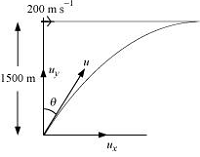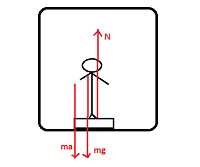CBSE 11TH PHYSICS - Online Test
There are three rules on determining how many significant figures are in a number:
- Non-zero digits are always significant.
- Any zeros between two significant digits are significant.
- A final zero or trailing zeros in the decimal portion ONLY are significant.
So keeping these rules in mind, there are 3 significant digit.

Instantaneous speed is the slope of the line at that point.
According to given image
Slope of line at x2 =
= 122.7
A fighter plane flying horizontally at an altitude of 1.5 km with speed 720 km/h passes directly overhead an anti-aircraft gun. At what angle from the vertical should the gun be fired for the shell with muzzle speed 600 m to hit the plane? At what minimum altitude should the pilot fly the plane to avoid being hit ? (Take g = 10 m).
Height of the fighter plane = 1.5 km = 1500 m
Speed of the fighter plane, v = 720 km/h = 200 m/s
Let θ be the angle with the vertical so that the shell hits the plane. The situation is shown in the given figure.

Muzzle velocity of the gun, u = 600 m/s
Time taken by the shell to hit the plane = t
Horizontal distance travelled by the shell = uxt
Distance travelled by the plane = vt
The shell hits the plane. Hence, these two distances must be equal.
uxt = vt
u Sin θ = v
Sin θ =
θ = Sin-1(0.33) = 19.50
In order to avoid being hit by the shell, the pilot must fly the plane at an altitude (H) higher than the maximum height achieved by the shell.
∴ H =
=
= 16006.482 m
≈ 16 km
When the lift moves downward with acceleration = 5 ms-2 the net force acting downward

R = 350 N
therefore reading on the scale =
Work done by force applied against gravity for one lift will be
So work done for 1000 lifts = 49 x 1000 = 49000 J
